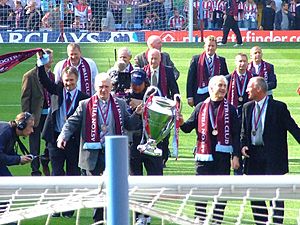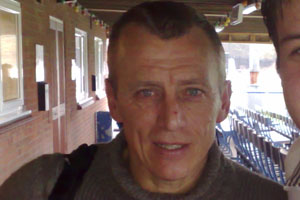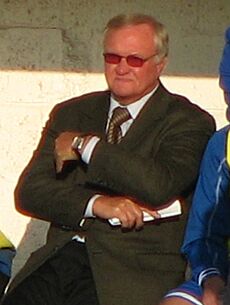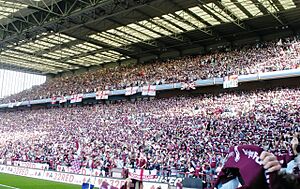History of Aston Villa F.C. (1961–present) facts for kids
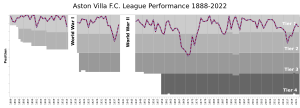
The history of Aston Villa Football Club from 1961 until now shows how the team's luck changed a lot. They faced tough times in the 1960s and 1970s. But then they won the amazing European Cup in 1982. Today, they are a team in the top Premier League.
The late 1960s were difficult for the club. In 1967, under manager Dick Taylor, the team was moved down from the top league. This was the third time it happened. Within two years, fans were very unhappy. This led to the club's leaders resigning. The team then dropped even further, to the Third Division.
In the 1971–72 season, Aston Villa made a great comeback. They won the Third Division with a record 70 points. This brought them back to the Second Division. In 1974, Ron Saunders became manager. By 1975, he led the club back to the First Division. They also started playing in European competitions.
Under Saunders, Villa had much success. They won the league in the 1980–81 season. But Saunders surprisingly left halfway through the 1981–82 season. At that time, the club was in the quarter-finals of the European Cup. His assistant, Tony Barton, took over. Barton guided them to a 1–0 victory over Bayern Munich in the European Cup final in Rotterdam.
Winning the European Cup was a huge moment. But after this, the club slowly dropped down the league. They were moved down again in 1987. However, they were promoted back the very next year. In 1989, under manager Graham Taylor, they finished second in the Football League.
Villa was one of the first teams to start the Premier League in 1992. They finished second to Manchester United in the first season, 1992–93. The 1990s were a mixed bag. The club had three different managers. Their league positions changed a lot, even though they won two League Cups.
In 2000, they reached the FA Cup final for the first time since 1957. But they lost 1–0 to Chelsea. This was the last game played at the old Wembley Stadium. Villa's league position kept changing with different managers. In 2006, David O'Leary left the club after some disagreements.
Martin O'Neill then arrived and was welcomed by fans. After 23 years as chairman, Doug Ellis sold his share. Randy Lerner, who owned an American football team, bought the club. A new owner and manager brought big changes. These included a new team badge, a new kit sponsor, and new players in 2007.
In 2007–08, Villa qualified for the Intertoto Cup. In the 2008–09 season, they reached the group stage of the UEFA Cup. This was their first time in seven years. The first big final under Randy Lerner was the 2010 Football League Cup Final. Villa lost 2–1 to Manchester United.
Martin O’Neill resigned before the 2010–11 season. He was replaced by Gérard Houllier. After health problems, Houllier was replaced by Alex McLeish. McLeish's contract ended in 2012 after the team barely avoided being moved down. In 2012, the club announced a loss of £53.9 million.
Paul Lambert replaced McLeish in July 2012. Lerner put the club up for sale in May 2014. In the 2014–15 season, Aston Villa scored only 12 goals in 25 league games. This was the lowest in Premier League history. Lambert was fired in February 2015.
Tim Sherwood took over and saved Villa from being moved down in 2015. He also led them to the 2015 FA Cup Final. But he was fired in October 2015. Rémi Garde replaced him but left in March 2016. The club was at the very bottom of the table. They were moved down from the Premier League on April 16.
In June 2016, Chinese businessman Tony Xia bought the club for £76 million. Roberto Di Matteo became manager but was soon replaced by Steve Bruce. In the 2017–18 season, Villa lost the 2018 EFL Championship play-off final at Wembley Stadium. In July 2018, Aston Villa was sold by Xia to Nassef Sawiris and Wes Edens.
They fired Bruce and hired Dean Smith. Smith led the team back to the Premier League. They won the 2019 EFL Championship play-off final. The club spent a lot of money on new players in 2019. They reached the EFL Cup final but lost to Manchester City. Villa managed to stay in the Premier League on the last day of the season.
The next season, Villa continued to spend on players like Matty Cash and Ollie Watkins. They finished 11th in the Premier League. In 2021–22, Villa sold captain Jack Grealish for a record £100 million. They also bought Emiliano Buendía for a record £33 million. Dean Smith was sacked in November 2021 after five losses.
Steven Gerrard took over as manager. He had just won the Scottish Premiership. Gerrard signed Philippe Coutinho and Lucas Digne. Villa finished the season in 14th place. The 2022–23 season started poorly. Gerrard was sacked in October 2022.
On October 24, 2022, Villa appointed Unai Emery as head coach. Emery quickly turned things around. Villa won 15 of 25 league games under him. They set a new Premier League record for scoring in 20 games in a row. Emery was named Premier League Manager of the Month in April 2023.
A 2-1 win over Brighton on the final day secured 7th place. This meant Villa qualified for the UEFA Europa Conference League. It was their first time in European football since 2010–11. Under Emery, striker Ollie Watkins broke records for scoring in consecutive games. Goalkeeper Emiliano Martínez also set a record for clean sheets.
After the 2022–23 season, there were more changes in leadership. Monchi joined as President of Football Operations. Chris Heck became President of Business Operations. The club broke its transfer record again. They signed French winger Moussa Diaby for £51.9 million.
Contents
A Time of Change and Challenges (1960s)
Winning the League Cup in 1961 was a big achievement. But after that, things started to go downhill. Villa finished 15th in 1963 and near the bottom in 1964. Manager Joe Mercer left in July 1964 because of these results.
His replacement, Dick Taylor, managed to keep Villa from being moved down in 1965. But the next year, Villa finished 16th again. After a 4–2 loss to Everton, the club was moved down to the Second Division in 1967. Dick Taylor was fired.
The club's leaders were also blamed. They had not kept up with modern football. They hadn't found new players or built a good coaching system. They also sold two of Villa's best players, Phil Woosnam and Tony Hateley. Fans became very vocal, asking the board to resign. Villa finished 16th in the Second Division in 1968.
Things got worse in November 1968. Villa was at the bottom of Division Two. The board fired manager Tommy Cummings. On November 21, 1968, a board member resigned. The board then announced that Aston Villa F.C. was for sale. London financier Pat Matthews bought control of the club. He brought in local travel agent Doug Ellis as the new chairman. Two days later, Tommy Docherty was appointed manager.
Building a Stronger Team (1970s)
Docherty helped the team regain confidence. Villa won five games in a row and stayed in the Second Division. More fans started coming to games. In the summer of 1969, the club raised £200,000 from selling shares. Most of this money was spent on new players.
However, the next season, Villa struggled to win games. By Christmas 1969, they were at the bottom of the Second Division. Docherty was fired. His replacement, Vic Crowe, could not stop the team from being moved down. For the first time, Villa was in the third tier of English football in 1970.
Despite finishing fourth in the Third Division in 1971, Villa reached the League Cup final. They beat Manchester United in the semi-final. But they lost 2–0 to Tottenham Hotspur in the final.
The 1971–72 season saw the club return to the Second Division. They were champions with a record 70 points. In 1972, there was a disagreement among the club's leaders. Four directors voted to remove Doug Ellis from the board. But Ellis was back as chairman within 43 days. He had the support of the largest shareholder and the fans.
In their first season back in the Second Division, 1972–73, Villa almost got promoted again. But they finished third. The next season, Villa finished 14th. Ellis fired Crowe and hired Ron Saunders.
For the club's 100th season, 1974–75, Saunders brought in only two new players. At the end of his first season, Villa was back in the First Division. They also won the 1975 League Cup final at Wembley Stadium. Villa beat Norwich City 1–0.
At the start of the 1975–76 season, Doug Ellis resigned as chairman but stayed on the board. Villa was in a good position. They were in the First Division and the UEFA Cup for the first time. Their first European season was short. They lost to Antwerp in the first round.
The next season, Villa finished fourth in the League. They reached the FA Cup quarter-finals. In the 1976–77 season, they won the League Cup again. They beat Everton 3–2 in the 1977 Final after a second replay.
Winning the League and European Cup
In the 1977–78 season, Villa reached the quarter-finals of the UEFA Cup. They lost 4–3 to Barcelona. In the league, they struggled. Saunders started to rebuild the team. In 1979, Doug Ellis resigned from the board again.
Saunders signed several new players. These players became very important to Villa. Allan Evans, Ken McNaught, and Kenny Swain joined the defense. Des Bremner joined the midfield with Dennis Mortimer and Gordon Cowans. Tony Morley and Gary Shaw were the new attackers. When Peter Withe joined in 1980, Saunders had built a winning team.
Their first big success was in the 1980–81 season. Villa won their first League Championship in 71 years. They beat Liverpool and Ipswich Town. They used only 14 players all season. The title was won on the last day of Villa's season. They lost to Arsenal but still finished top. Ipswich Town, their rival, lost to Middlesbrough. Fans at the game listened to the Ipswich game on their radios.
The next season, Villa did not start well in the league. They were in the middle of the table by Christmas. But the club was still in the European Cup. In the first round, Villa beat Valur 7–0. In the second round, they drew 2–2 with BFC Dynamo. Villa went through because of the away goals rule.
By February 1982, the club was 19th in the First Division. Saunders resigned. It was later said that the chairman offered him a short-term contract, which he refused. Saunders' assistant, Tony Barton, became manager. When Barton took over, Villa was in a bad league position. But they were in the European Cup quarter-final.
In the quarter-finals, they beat Dynamo Kiev. Gordon Cowans said, "Once we got past Dynamo Kiev we began thinking we could go all the way." In the semi-final, they played Anderlecht. Tony Morley scored to send Aston Villa to the final.
European Champions and Later Struggles
On May 26, 1982, just three months after becoming manager, Barton led Villa to victory. They beat Bayern Munich 1–0 in the European Cup final in Rotterdam. As of November 2020, Villa is one of only five English teams to have won the European Cup. They were not expected to win the final.
The final was held in Feyenoord Stadium. Nine minutes into the game, Villa's experienced goalkeeper Jimmy Rimmer got injured. He was replaced by 23-year-old reserve goalkeeper Nigel Spink. Spink had only played one match for the club in five years. Spink played very well against Bayern's strong attackers. Other key players were Tony Morley, Gordon Cowans, and Dennis Mortimer.
After winning the cup, the team did not have more success. They played badly in the following seasons. In October 1982, it was revealed the club was £1.6 million in debt. This was due to high wages and building costs. In November, Doug Ellis bought shares and returned as chairman.
In January 1983, Villa beat Barcelona 3–1 to win the 1982 UEFA Super Cup. Barton stayed in charge for two seasons after the European Cup win. But he was fired at the end of the 1983–84 season. Villa finished tenth in the First Division that year. Graham Turner became the new manager.
Turner could not stop the decline. In 1986, Villa barely avoided being moved down. A bad start to the next season led to Turner being fired. Billy McNeill was hired but could not save Villa from being moved down. They went to the Second Division just five years after winning the European Cup. McNeill left for Celtic. Doug Ellis convinced Graham Taylor to take over and rebuild the team.
New Managers and Premier League Era
Taylor's first season at Villa ended with promotion. They finished second in the Second Division. David Platt was a key player that season. He had joined from Crewe Alexandra for £200,000. Before he left in 1991, Platt scored 68 goals for the club.
Villa avoided being moved down on the last day of the 1988–89 season. In the 1989–90 season, they surprised everyone by challenging for the title. They led the league for three weeks. They finished second, nine points behind Liverpool. Taylor left to manage the England team.
Slovak coach Jozef Vengloš became the new manager. He was the first foreign manager in the First Division. The 1990–91 season was Vengloš's only season. Villa qualified for the UEFA Cup. This was after English clubs were allowed back into European competitions. They beat Baník Ostrava. They won the first leg against Inter Milan but lost the second.
This defeat started a decline. By the end of the season, they were close to the relegation zone. Vengloš stepped down. David Platt was sold to Italy for £5 million. The new manager was Ron Atkinson. In his first season, 1991–92, Villa finished sixth. This made them one of the founding members of the FA Premier League.
Villa in the Premier League
In his first 18 months, Atkinson bought several new players. These included Dean Saunders and Dalian Atkinson. They helped the club finish second to Manchester United in the first Premier League season, 1992–93. Saunders and Atkinson formed a successful attacking duo.
On March 27, 1994, Villa won the League Cup final 3–1. This earned them another UEFA Cup spot. But their Premier League form dropped, and they finished 10th. At the end of the 1993–94 season, they played their last game at a standing-only Villa Park. It was then changed to an all-seater stadium. In November 1994, Atkinson was fired after a bad start to the season.
Brian Little became the new manager. He kept Villa in the Premiership. In 1995, he changed the team. He sold older players and bought younger ones. Villa won the 1996 League Cup. They also reached the FA Cup semi-finals. They finished fourth in the Premiership in the 1995–96 season.
In February 1998, Little resigned. He said things behind the scenes were affecting his job. Doug Ellis disagreed, saying it was due to pressure from fans.
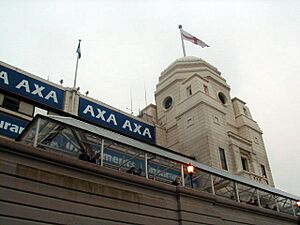
Ellis appointed John Gregory as Little's replacement. Gregory improved the team. Villa finished seventh in the Premiership and qualified for the UEFA Cup. This was unusual, as usually only the top six teams qualified.
Despite selling Dwight Yorke for £12.6 million in 1998, John Gregory led Aston Villa to the top of the Premiership. Villa reached the FA Cup final in 2000. But they lost 1–0 to Chelsea. This was the last final played at the old Wembley Stadium.
The 2000–01 season saw Villa finish eighth. They qualified for the UEFA Cup by winning the Intertoto Cup in August 2001. In November 2001, Gregory criticized Ellis. He later had to apologize. Their relationship was tense. Gregory resigned on January 24, 2002.
In January 2002, Ellis brought back Graham Taylor as manager. Villa finished the 2001–02 season in eighth place. Taylor quit for the second time after the 2002–03 season. Villa had finished 16th and lost twice to rivals Birmingham City.
David O'Leary became Taylor's replacement. He had led Leeds United to the Champions League semi-finals. He took the team to sixth place. But they narrowly missed a UEFA Cup spot. In 2005–06, Villa dropped to 16th place. This was despite O'Leary spending over £13 million on players.
In July 2006, some Villa players criticized Ellis. They said he was not spending enough money. The club denied it. But it became clear that players were unhappy. The next week, O'Leary left the club.
The Randy Lerner Years
On August 4, 2006, Doug Ellis introduced Martin O'Neill as the new manager. O'Neill said he wanted to bring the team back to its glory days.
After many years, Doug Ellis's 23-year time as chairman ended. He decided to sell his shares. Fans had wanted him to resign for a long time. His decision was likely due to his health. Randy Lerner, owner of the American football team Cleveland Browns, was chosen to buy the club. On August 25, he bought 59.69% of the shares. By September 26, he owned 90% and completed the takeover. Lerner appointed new people to the board. Ellis was given a special "Life President" role.
The new owner and manager brought big changes. These included a new badge, a new kit sponsor, and new players in 2007. Aston Villa started the 2006–07 Premiership campaign well. They finished 11th with 50 points. They ended the season with nine unbeaten league games. The last home game celebrated the 25th anniversary of Villa winning the European Cup. The 1982 team paraded the trophy.
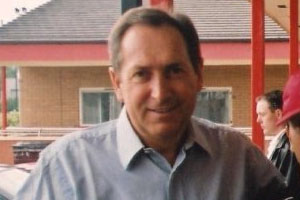
In 2007–08, Villa finished sixth. This qualified them for the Intertoto Cup. They won against Danish side Odense BK. This put Villa into European competition for the 2008–09 season. They reached the group stage of the UEFA Cup. They won their first match against Ajax 2–1.
The first major final under Lerner was the 2010 Football League Cup Final. Villa lost 2–1 to Manchester United. Five days before the 2010–11 season, O'Neill resigned. The reserve team coach, Kevin MacDonald, became caretaker manager. On September 8, 2010, Gérard Houllier became manager.
On April 20, 2011, Houllier went to the hospital with chest pains. He had a heart problem again. His assistant, Gary McAllister, took over for the last games. On June 1, 2011, Houllier left the club. Villa was looking for its fifth manager that year. Houllier was replaced by Alex McLeish on June 17, 2011. Many fans protested his appointment. He was the first manager to move directly from Birmingham City to Villa.
McLeish's contract ended after the 2011–12 season. Villa finished 16th, just above the relegation zone. On July 2, 2012, Aston Villa appointed Paul Lambert as manager. In February 2012, the club announced a financial loss of £53.9 million. Lerner put the club up for sale on May 12, 2014.
In the 2014–15 season, Aston Villa scored only 12 goals in 25 league games. Lambert was fired on February 11, 2015. Tim Sherwood replaced him. He saved Villa from relegation and took them to the 2015 FA Cup Final.
Sherwood was fired on October 15, 2015, after six league losses. Kevin MacDonald became interim manager. On November 2, 2015, Rémi Garde became manager. But he left on March 29, 2016. The club was at the bottom of the table. They were moved down from the Premier League on April 16.
Championship Football and New Owners
In June 2016, Chinese businessman Tony Xia bought the club for £76 million. Roberto Di Matteo was appointed manager for the new season in the Championship. He was sacked after 12 games. The club was in 19th place, having won only one match.
Steve Bruce replaced him. Bruce led the club to 13th place that season. In the 2017–18 season, Bruce led Villa to fourth place. They had their best winning streak since 1990. They qualified for the play-offs and beat Middlesbrough. But they lost 1–0 to Fulham in the 2018 EFL Championship play-off final.
After the play-off final, financial problems appeared. Xia struggled to get money out of China. On June 5, 2018, Aston Villa missed a £4 million tax payment. The club faced closing down. On June 7, Xia made a deal to pay £500,000 of the bill. He promised to pay the rest later. This saved the club for a short time. But it was clear the club needed new owners.
Sawiris and Edens Take Over
In July 2018, Nassef Sawiris and Wes Edens took over Aston Villa. They bought a 55% share. They promised to invest a lot of money. In October 2018, they fired Bruce. Villa was 12th in the table. They appointed Dean Smith, a lifelong Villa fan.
Under Smith, the team improved. They had a record 10-game winning streak in March and April. The team finished 5th in the league. They were in the play-offs for the second time. They won the play-off final on May 27, 2019. They beat Derby County 2–1. This brought them back to the Premier League after three years.
The club spent £144.5 million on 12 new players in summer 2019. In the EFL Cup, Villa reached the final. They lost 2–1 to Manchester City. In the league, Villa was in the relegation zone with four games left. But they managed to stay up on the last day. They drew 1–1 with West Ham United.
Villa continued to spend heavily the next season. They signed Matty Cash, Ollie Watkins, and Emiliano Martínez. Villa stayed in the Premier League, finishing 11th.
The 2021–22 began with Villa selling captain Jack Grealish for £100 million. This was a British transfer record. They also bought Emiliano Buendía for £33 million, a club record. Smith's team started slowly. In November 2021, Dean Smith was sacked after five losses.
He was replaced by Steven Gerrard. Gerrard had just won the Scottish Premiership. In January, Gerrard signed Philippe Coutinho and Lucas Digne. Results were mixed. Villa finished the season in 14th place.
The 2022–23 season also started poorly. Gerrard was sacked in October 2022. On October 24, 2022, Villa appointed Unai Emery as head coach. Emery won his first match 3–1 against Manchester United. Villa won 15 of 25 league games under Emery. They set a new Premier League record for scoring in 20 games in a row.
Emery was named Premier League Manager of the Month in April 2023. A 2-1 win over Brighton secured 7th place. This qualified Villa for the UEFA Europa Conference League. It was their first European competition since 2010–11.
Under Emery, Ollie Watkins broke the record for scoring in five consecutive Premier League games. He also scored in six consecutive away games. Emiliano Martínez set a record for clean sheets. Villa won five Premier League games in a row for the first time since 1998. They also won seven home league games in a row.
After the 2022–23 season, there were more changes in leadership. Monchi became President of Football Operations. Chris Heck became President of Business Operations. The new leaders oversaw new player signings. Aston Villa broke its transfer record again. They signed French winger Moussa Diaby for £51.9 million.


